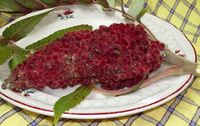
Now is the time to begin thinking about gathering sumac to dry for winter. I plan to dry some for use as a spice and as lemonade, as well as to make vinegar syrup now. Vinegar syrup can be made from just about any fruit and makes a delicious drink either hot or cold. Store corked in a cool place.
500 mL [2 cups] fruit or berries
500 mL [2 cups] vinegar I use white wine or distilled
1.1 L [4 1/2 cups] sugar
Steep the fruit and vinegar in a non-reactive pot for 8 days; the level of the vinegar should not submerge the fruit. Strain through a silk strainer [or a stocking]. Set aside 500 mL [2 cups] syrup.
In a bain marie [double boiler], dissolve the sugar and the syrup until there are no crystals left. Remove from the heat and let cool. Bottle. To serve, pour one part syrup for three parts water, cold or hot. Be ready for an amazing taste!
Recipe: A Taste of history: the origins of Quebec's gastronomy, Marc Lafrance & Yvon Deslonges. Canadian Parks Service, 1989, p.68.
See also: Sumac Lemonade





